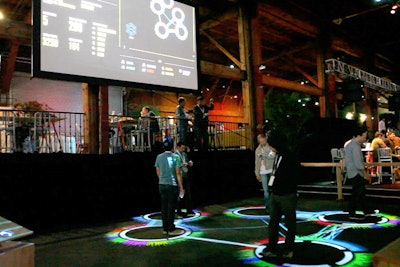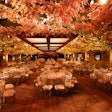
Attracting developers and entrepreneurs from around the world, Facebook’s F8 Developer Conference is designed to inspire attendees and showcase innovation in social media. Established in 2007, the conference has become a forum for developers and a launch pad for important Facebook announcements. The idea of the social graph was first discussed at F8 in 2007, the “like” button got its start at the 2010 conference, and in September of last year, C.E.O. Mark Zuckerberg introduced the Timeline profile feature.
In addition to keynotes, breakout sessions, and product launches at the 2011 conference at the San Francisco Design Centre, an interactive installation called Connections brought Facebook to life on the show floor. Developed by creative technology agency Obscura Digital, the augmented-reality space created a physical version of Facebook. “Facebook wanted to show that their services are not just about connecting the people behind a screen, be that a computer or mobile phone,” said James Hurlbut, interactive developer at Obscura Digital.
“[They wanted] to show how you can use the services in a physical setting without any screens or keyboards.” A team of Obscura developers worked with Facebook art director, Ben Barry, to create the Connections activation.
Guests checked into the enclosed Connections space with a radio frequency identification (R.F.I.D.) tag that linked to their Facebook profiles. Using the information from their profile, overhead projectors mapped a personalized spotlight onto the ground, color-coded to represent interests, work places, birth sign, and Facebook likes. Four 3-D cameras tracked movements, and as participants approached each other, lines would connect their spotlights and a slideshow of common interests or friends flashed between connected guests. “You had people from totally different countries or just totally different space,” Hurlbut said. “They would walk up to each other and, all of a sudden, a familiar photo would pop up as if by magic between them. It was a really futuristic way to connect people.”
The sophisticated activation used top-of-the-line tracking equipment, high-definition projectors, and speedy, custom software. Although the project was a success, it came with challenges including changing lighting conditions in the venue’s concourse, large groups of people, and unknown data variables. “Whenever you’re dealing with live, real data, it’s very hard to know the maximum amount of information you’re going to have to process,” Hurlbut said. “You could get two people in there with 10 friends or you could get 20 people with 2,000 friends.”
The goal of Connections was two-tiered: to highlight Facebook’s R.F.I.D. capabilities and make a big impact. “[The attendees] are the developers, so these guys are pretty technical,” Hurlbut said. “They’ve seen a lot, and it takes a lot to impress them with software.” The activation was a hit, and hundred of guests lined up to try it.
Previous: #12 I.B.M. Information on Demand
Next: #14 South by Southwest Interactive



















